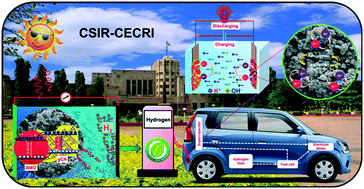Construction of heterostructure based on hierarchical Bi2MoO6 and g-C3N4 with ease for impressive performance in photoelectrocatalytic water splitting and supercapacitor†
Abstract
Herein, we report the synthesis of a nanohybrid material with hierarchical Bi2MoO6 and g-C3N4 by a solvothermal method. It shows impressive performance towards photoelectrocatalytic water splitting and supercapacitor applications due to the formation of type-II heterostructures, a higher surface area of 60.7 m2g−1 (Bi2MoO6 – 44.0 m2 g−1) and higher wettability. The formation of type-II heterostructures reduces the electron–hole recombination and boosts up the interfacial charge transfer in g-C3N4/Bi2MoO6, and the nanohybrid material (10 wt% g-C3N4) shows about 7- and 20-fold higher PEC efficiency than that of Bi2MoO6 and g-C3N4 under illumination (100 mW cm−2 (AM 1.5G)). Besides, due to the combination of non-faradaic and faradaic processes, g-C3N4/Bi2MoO6 (5 wt% g-C3N4) exhibits a high specific capacity of 1628 C g−1 at a current density of 2 A g−1 in a three-electrode configuration. The symmetric supercapacitor delivers a maximum cell voltage of 1.8 V with a high energy density and a power density of 47 W h kg−1 and 4500 W kg−1, respectively, and also shows excellent electrochemical stability with 90% capacitance retention even after 10 000 cycles at a current density of 5 A g−1.



 Please wait while we load your content...
Please wait while we load your content...